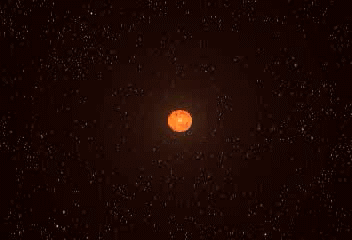
There has been recent speculation that a good place to look for life might actually be near a white dwarf. This possibility had been rejected before, mostly because it is hard to see how a planet could get into the right spot. For example, in about 4 billion years the sun will expand into a red giant that will engulf Mercury and Venus and probably the Earth -- if Earth is not swallowed, it will at least be thoroughly roasted, with the atmosphere and oceans all boiled off. Then the sun will throw off its outer layers as a planetary nebula and shrink down to a white dwarf about the size the Earth is today. The nearest surviving planet will be Mars, but the sun will be only a very bright pinprick -- it will look a bit smaller from Mars than it currently looks from Pluto.
The reason the new research has caused some excitement is it has shown that there can be a "habitable zone" suitable for liquid water that would last for billions of years -- depending on the mass of the white dwarf, potentially much longer than the current age of the Earth. Since many stars will end up as white dwarfs, maybe they are a good place for life to take hold in the future. Maybe some of them have life even now!
There are at least three main problems with this idea. The first is the size of the habitable zone: the planet must be almost as close to the white dwarf as the moon is to the Earth, and remember, in the red giant phase the star will have cleared out the area around it. Probably the only way to get a planet there would be to have a Jupiter-sized planet engulfed by the star during its red giant phase. Most of the planet would be boiled off, but maybe, if it was engulfed only at the end of that phase, the planets core would survive. Drag in the star's atmosphere would cause the planet's core to spiral inward. Having the core both survive and get that close to the core of the star (which becomes the white dwarf) without hitting it seems very unlikely.
Or, maybe, there would be some debris in the neighborhood of the white dwarf from which a new planet could form. Since the white dwarf forms by blowing off the outer layers of the star, I'm doubtful.
The second problem is related to the first. If the planet was engulfed by the star's outer layers, all the volatile elements should be expected to boil off, even it some core survives. You might have iron and silicon, but probably no water. If, on the other hand, the planet is somehow captured, tidal forces will quickly circularize the orbit and synchronize its rotation with its orbit. This will not be a gentle process; orbital and rotational energy will have to be shed in the process, and this will dramatically heat the planet. The best analogy is probably Jupiter's moon Io; tidal flexing from Jupiter has made Io the most volcanic body in the solar system, and it has already blown off all its water. For our proposed planet, the situation would be even worse.

My last concern may be a positive, may be a negative, or may not matter at all! It is star-grazing comets. Each year many comets are discovered near the sun, which after all is the bottom of the solar system's gravitational well. Many actually fall into the sun, and of course that is the end of them. Something similar should happen with other stars, and it would be barely affected by the red giant and white dwarf stages.
A planet in a white dwarf's habitable zone is still a tiny target, and almost all comets would miss it, regardless of where it might be -- but near the white dwarf, it would have an enhanced likelihood of cometary impacts. Furthermore, those impacts would be at a higher velocity, since the comet would pick up speed as it falls in toward the white dwarf.
This might make the planet unfavorable to life, since it would be in the middle of a shooting gallery. On the other hand, maybe the comets could deliver water that was lost in the process of bringing the planet so close to the white dwarf.

No comments:
Post a Comment